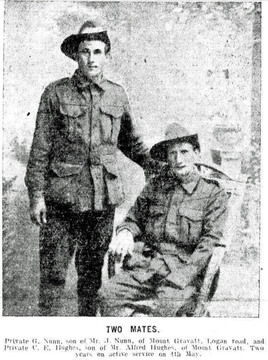NUNN, George
| Service Number: | 5055 |
|---|---|
| Enlisted: | 13 January 1916, Brisbane, Qld. |
| Last Rank: | Private |
| Last Unit: | 25th Infantry Battalion |
| Born: | South Brisbane, Qld., 26 October 1890 |
| Home Town: | Brisbane, Brisbane, Queensland |
| Schooling: | Not yet discovered |
| Occupation: | Labourer |
| Died: | 6 July 1965, aged 74 years, cause of death not yet discovered, place of death not yet discovered |
| Cemetery: |
Mount Gravatt Cemetery & Crematorium, Brisbane MONUMENTAL-4B-2-70 |
| Memorials: | Holland Park Mount Gravatt Roll of Honour, Tingalpa Shire Roll of Honour |
World War 1 Service
| 13 Jan 1916: | Enlisted AIF WW1, Private, 5055, 25th Infantry Battalion, Brisbane, Qld. | |
|---|---|---|
| 4 May 1916: | Involvement Private, 5055, 25th Infantry Battalion, --- :embarkation_roll: roll_number: '15' embarkation_place: Brisbane embarkation_ship: HMAT Seang Choon embarkation_ship_number: A49 public_note: '' | |
| 4 May 1916: | Embarked Private, 5055, 25th Infantry Battalion, HMAT Seang Choon, Brisbane |
Help us honour George Nunn's service by contributing information, stories, and images so that they can be preserved for future generations.
Add my storyBiography contributed by Ian Lang
Son of James NUNN and Louisa nee EASY of Mount Gravatt, South Brisbane, Qld.
George Nunn was a 25 year old single labourer who lived with his mother at Mount Gravatt. He enlisted on 13th January 1916. After spending some time in depot battalions at Enoggera, George, now in the 25th Battalion embarked on the “Seang Choon” with other reinforcements for Queensland battalions in Egypt.
George arrived in Suez on 15th June 1916. The bulk of the 25th had left Egypt the previous March and were already at the front. George remained in camp until being hospitalised with tonsillitis at the #2 Australian Hospital at Tel-El-Kebir. He spent two months in hospital and convalescent depots until finally gaining transport to France.
The 25th had sustained numerous casualties at Pozieres in July and August 1916 and were awaiting reinforcements in the back areas around Albert. George joined them on 17th October. The winter of 1916/17 was one of the harshest on record and the Australian infantry manning the lines suffered severely. With the spring of 1917, the Germans began an orderly withdrawal east to pre-prepared defensive positions. George’s first major action was against the Hindenburg Line at Bullecourt in April 1917.
The British offensive moved north from the Somme to Flanders in the summer of 1917. The 25th Battalion were in the advance at Menin Road and Broodseinde Ridge before becoming hopelessly bogged in the mud at Passchendaele. After such an exhausting campaign, George was granted two weeks leave.
In 1918, the action moved back to the Somme. Two Australian divisions finally halted the German advance at Villers Bretonneux and Monash began a period of what he called peaceful penetration on both sides of the Somme. One of these actions was an attack at Morlancourt on 10th June 1918. The 25th Battalion were the spearhead for the attack, which resulted in the battalion being awarded 1 DSO, 2 Military Crosses and 10 Military Medals. Among the casualties was George Nunn who sustained a gunshot wound to the forearm, resulting in a compound fracture. There is conflicting evidence in the records as to whether it was the left or the right arm that was injured. Nevertheless, George was evacuated from the front back to England, being admitted to the Bath War Hospital on 27th June.
Probably with his arm still in a cast, George was transferred to Harefield Hospital, and was granted a 14 day furlough. He returned to Harefield and then to a convalescent depot. On the 2nd of September 1918, George was charged with “Failure to salute an officer of the Military Forces.” If it was indeed his right arm that was injured then he perhaps had a valid excuse.
By the 16th October, George boarded a transport ship bound for Australia. The war ended while he was at sea and he was discharged in Brisbane on 28th February 1919. George made a claim for repatriation benefits in 1965.









